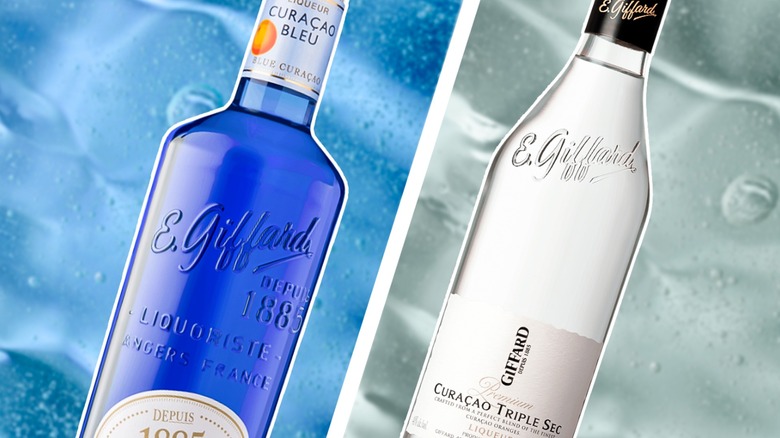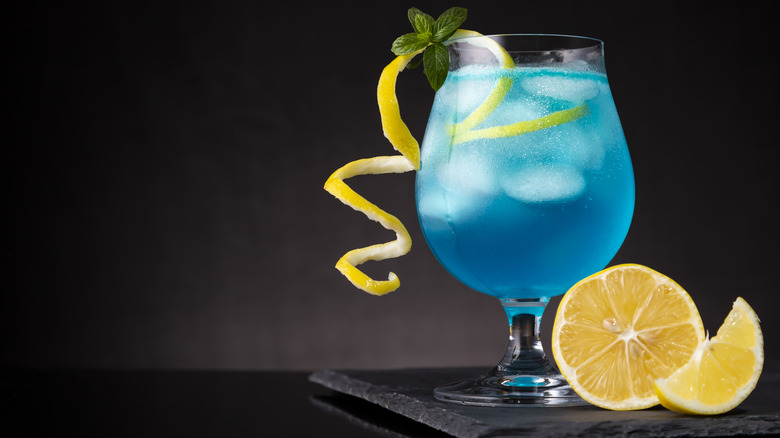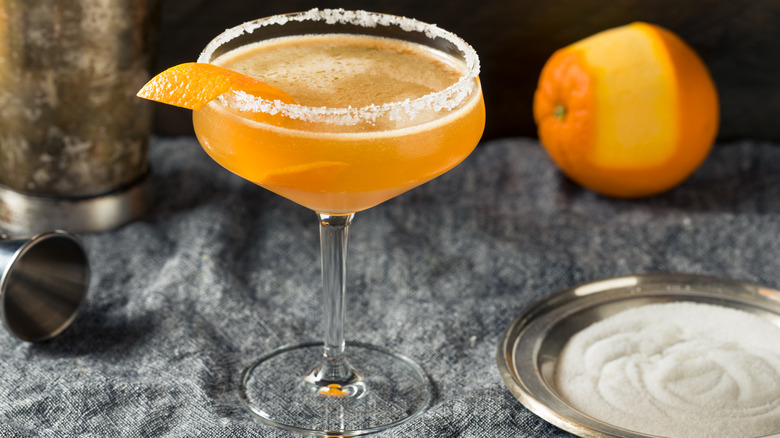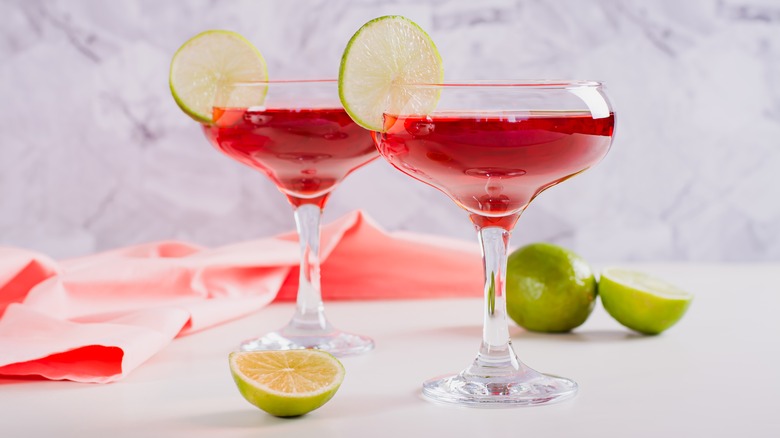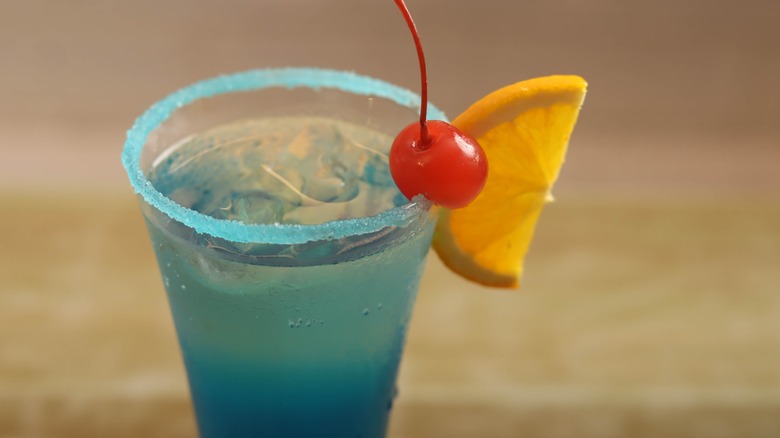Is Blue Curaçao The Same As Triple Sec?
Simply put, no, blue Curaçao is not the same as triple sec. In fact, if you ask this snobbish former career bartender turned spirits writer, the two could hardly be more different. As such, we'll start by naming their similarities, since the list is so terrifically limited. Both blue Curaçao and triple sec are flavored liqueurs used to build complex cocktails, often (but not always) of the tiki variety. It would be bizarre to spy a friend sipping triple sec or Curaçao on the rocks (to each their own, but if you see something, say something). Triple sec and blue Curaçao also tote roughly the same boozy potency, and they're both classes of orange-flavored liqueur. Some bartenders even use the two ingredients interchangeably; this is wrong.
Blue Curaçao is the darling of the near-universally-dogged-upon '80s cocktail era, which gave birth to such semi-enduring classics as the blue Hawaiian and blue lagoon (named after the eponymous 1980s romantic drama starring Brooke Shields). These are neon-hued, cloyingly sweet, viscous sippers that all get their color from (you guessed it) blue Curaçao. But, proto-Curaçao didn't just come in blue; bright red, green, and orange versions of the liqueur were originally produced during the early 1900s. Triple sec, on the other hand, is always mostly clear and always tastes like oranges, and that's just the beginning of the story between these two cocktail ingredient cousins.
What is blue Curaçao?
Blue Curaçao is an electric blue tinted liquer clocking in at around 15%-25% ABV. Despite its hue, blue Curaçao doesn't taste like berries — it tastes like orange, flavored with the Lahara orange peel from the quasi-indigenous, highly specialized fruit that grows on the eponymous Caribbean island of Curaçao. This beachy origin is largely to thank for blue Curaçao's unwavering stronghold on the tropical vacation cocktail scene, with bevys like the azure bikini martini (gin, blue Curaçao, peach schnapps, and lemon juice).
The Lahara orange is an evolution of the Spanish Seville orange, which was introduced to the island of Curaçao by Spanish explorers as early as 1527. The story goes that Curaçao was then controlled by Spain, and Spanish agriculturalists found their attempts to grow their prized oranges on the island thwarted by its dry, high-sun climate. This naturally sun-dried fruit grew into an inedibly bitter yet highly aromatic orange that was lousy for eating but ideal for steeping into a dimensional liqueur. Fast forward to 1896, and blue Curaçao was finally invented by Dutch settlers, who by then had gained control of the island. Dutch spirit brand Bols began selling it bottled in 1912. In America, blue Curaçao boomed during the '80s, but its roots had taken hold by the 1960s with the blue Hawaiian cocktail being named after the 1961 Elvis Presley flick "Blue Hawaii."
What is triple sec?
Triple sec is a category of orange liqueur with a punchy citrus flavor that's bright and fruit-forward. Unlike its cobalt cousin, triple sec is totally clear and ranges from tart-dry to notably sweet, with a comparable but wider potency range from 15%-40% ABV. Grand Marnier is technically classified as a triple sec-Curaçao hybrid, but it's made with cognac and clocks in at a full-proof 40% ABV.
To make triple sec, unripe, greenish orange peels are distilled in alcohol made from neutral fermented beet sugar. Then, the mixture is distilled once more with additional alcohol, water, and beet sugar. You can even make triple sec yourself at home – and if you opt for store-bought, there's a proper way to store your bottles, for the record.
Triple sec is an inventory fixture in any home bar worth the dusty glass cart on which it stands. Triple sec is a foundational ingredient in a classic margarita. In fact, celebrity chef and tv personality Alton Brown caught major backlash for omitting triple sec from his go-to marg recipe (yikes). It's also crucial in cocktail pillars like the Long Island iced tea, mai tai, kamikaze, and the trendy new viral Dr Pepper margarita (we don't recommend trying that one out for yourself).
Blue Curaçao lacks subtlety
When a cocktail contains blue Curaçao, you'll know right away. In mature, sophisticated cocktails such as the corpse reviver no. 2, cable car, and lemon drop martini, triple sec adopts the role of best supporting actor, bringing a citrusy orange peel flavor note while remaining in the background. This is also why it's a crucial ingredient for bringing balance to smoky cognac sidecars and sweet-acidic cranberry cosmopolitans.
Blue Curaçao, on the other hand, is the star of the show in every beverage containing it. As a general rule, bartenders use triple sec when they want to add orange flavor to a drink; they only use blue Curaçao if they're needing a shot of electric blue hue. There's a reason why its oeuvre of cocktails all feature the ingredient's namesake in their title. The blue Hawaiian, for instance, is essentially a pina colada with blue Curaçao added. Or consider the blue lady cocktail (gin, blue Curaçao, lemon juice, and egg white) or the China blue, a highball with blue Curaçao, lychee liquor, and grapefruit juice that remains popular along the Pacific Rim region. The ingredient's trademark hue comes from synthetic food coloring, particularly food dye E133 Brilliant Blue FCF, a rich pigment produced by petroleum (but totally safe to ingest in relatively small quantities). It's orange liqueur dyed blue — it's a gimmick and it rocks — but it is not triple sec.
Blue Curaçao tastes like bitter orange, while triple sec can be dry, bright, fruity, and sweet
Apart from color, triple sec and blue Curaçao also bring markedly different flavor profiles to the cocktail party. Despite its guilty-by-association reputation in ultra sweet tiki drinks, blue Curaçao on its own is far from sweet. It features bitter orange and vanilla top notes; much more bitter than triple sec. To make it, Lahara oranges are sliced, peeled, and sun-dried for five days, soaked in alcohol, infused with different proprietary blends of spices (frequently including cardamom and cloves), then hung in a burlap sack inside of a copper still for three days. Then, the distillers add more water and sometimes sugar to soak the mixture and distill for another three days, which produces a bitter, clear, orange-flavored liqueur. This production differs drastically from triple sec, which uses beet sugar liquor to sweeten every step of the way.
Triple sec is French in origin, with "sec" coming from the French word for "dry." Some sources substantiate that the "triple" in the name referential to the liquor being distilled three times, but this process can vary by brand and its significance to the name is debated. Nowadays, higher-end triple sec brands like Cointreau lean more dry and floral, while the bulk of mid and low-range triple secs are slightly sweet, instead presenting a gummy, fruit-forward orange citrus flavor.
